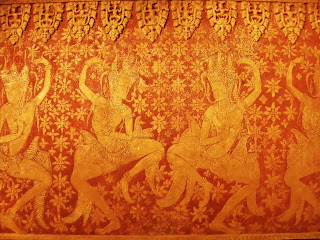But flights to those two destinations are expensive and long. So those exotic places are going to have to wait a while. Which is why, when I saw there was a show about Angkor here in Paris, I got out my subway pass and I was off to the 16th arrondissement and the Musée des Arts Asiatique Guimet.
Guimet’s collection covers artworks of just about any Asian nation you could name - from India, Afghanistan and Pakistan to Japan and Korea, from the Himalayas to Vietnam.
After all, France was one of the three great colonial powers of the past, alongside Great Britain and Spain. A huge swath of southeast Asia flew the French flag under the name Indochine (Indochina): Vietnam, Laos and Cambodia. In addition, Louis XIV, the Sun King, had also built trading settlements in India: Mahe, Chandernagor, Pondicherry, Karikal and Yanam - names all French children once had to learn in grade school. So what could be more normal than that Asian art, at least from these areas, should find its way into French museums and private collections?
I’m not sure, but I think the first time I heard of Angkor Wat was in college. As a French major, I was subjected to an inordinate number of Gallic books, one of which was André Malraux’s La Voie Royale (1930). In it, the “heros” penetrate the Indochinese jungle to steal bas-reliefs from ancient Khmer temples. And the author should know about that, because Malraux himself went to Cambodia in 1923 under the pretext of taking molds of Angkor Wat for the self-same Musée Guimet and instead sawed off statues and bas-reliefs with the intention of selling them to collectors he had already contacted. He was arrested in Phnom Penh and sentenced to over a year in prison, but his wife rallied the French intelligentsia who put so much pressure on the government that he was released after only three months. In spite of that buccaneer-ish start at age 23, Malraux nonetheless ended up as Minister of Culture in the DeGaulle administration and his body now reposes in the Panthéon alongside other great intellectuals such as Voltaire, Rousseau, Hugo, Dumas and Zola, as well as Marie and Pierre Curie.
But I digress. Back to Angkor Wat.
 |
| Tapestry |
In addition to Laporte’s drawings and the moldings, there are also actual statues from the 10th to the 13th century, some ornate, others touching in their simplicity. I’m not terribly familiar with the culture of Cambodia and not knowledgeable enough to recognize which of the gods is which. But there is so much to see in the bas-reliefs, and such beauty in the simple busts, that it doesn’t matter. The flow of the lines carries the eye from one detail to another.
A quick look at some of the literature explains to visitors that Angkor Wat was first a Hindu temple dedicated to Vishnu, then later a Buddhist one, which explains a bit of the dichotomy of the gods depicted. It was built by the Khmer King Suryavarman II early in the 12th century, which makes it even more amazing that anything at all has survived, given the threat of encroachment by the surrounding jungle. It’s the largest religious monument in the world, and has become the emblem of Cambodia, even featuring on the national flag.
It’s amazing that we can stand here today and look at these vestiges, because the moldings were stored for decades in the damp cellars of St. Riquier Abbey near Abbeville in the marshy Somme region well north of Paris. The exhibit’s experts found over 1,000 molds stacked in such a way that picking any of them up was like playing a gigantic Pick-Up-Sticks game ( Mikado in French) where moving one might well damage the others around it. After that, the pieces had to be assembled like some vast and intricate jigsaw puzzle. But the result is amazing. I find my hand keeps creeping out, wanting to touch them, but I don’t dare
 |
| Bayon temple |
Angkor, l’invention d’un mythe
until Jan. 13, 2014
Daily except Tuesday
10 a.m. to 6 p.m.
7.50-9.50€, reduced 5.50-7€
Musée des Arts Asiatique Guimet
6, place Iéna
75016 - Paris
01.56.52.53.00
http://www.youtube.com/watch?v=k9Txc3nl_OM








Incredible! The one bust you've shown is so life-like, I expected to hear it breathe!
ReplyDelete